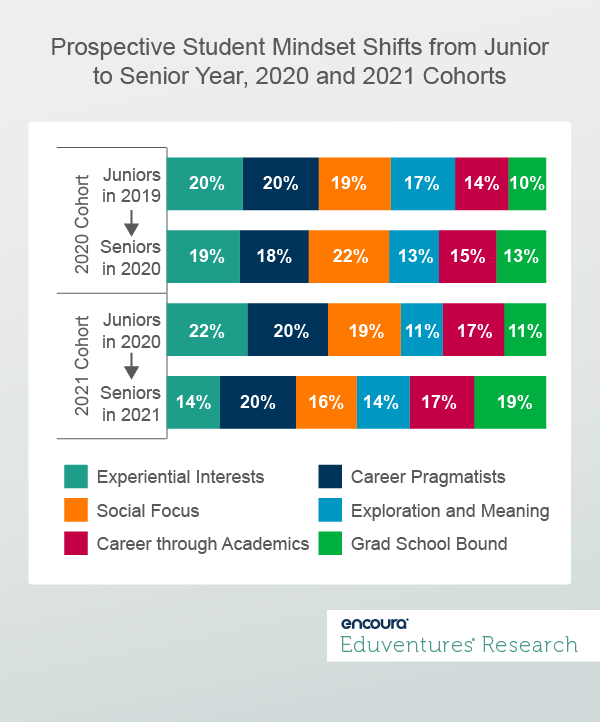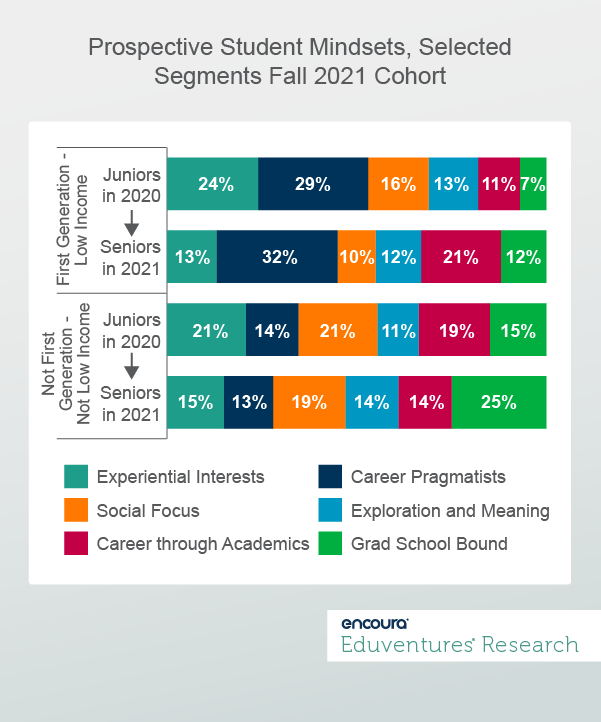Things are looking up. High school students are once again envisioning a full-fledged traditional undergraduate college experience. The COVID nightmare that pushed students into remote learning and deferred their dreams of a rich campus life is coming to an end.
But what lingering effect will this past year's experience have on the way current high school students approach their college choices? How can colleges and universities help students recover and reimagine what their college experiences might be going forward?
The clearest evidence we have that the pandemic has altered the expectations of college-bound high school students comes from an analysis of our prospective Student Mindsets™ (Mindsets). Figure 1 shows how students in the 2020 fall college enrollment cohort (pre-pandemic) and 2021 cohort (mid-pandemic) shifted their Mindsets between their junior and senior years. Notably, these Mindsets had remained remarkably stable for the five years preceding the pandemic.
We initially examined this data in February, but it’s worth discussing. These shifts are a signpost as to where students may be headed.

First, note how the 2020 Cohort—the class of students who were juniors in 2019 and became seniors in 2020—experienced relatively subtle shifts; most Mindsets only lost or gained a couple of percentage points. Pre-pandemic, this was typical. The 2021 cohort—students who were juniors in 2020 and became seniors in 2021—on the other hand, experienced much greater shifts.
Prior to the pandemic, two of the most prominent Mindsets nationally were Experiential Interest (students who want hands on experiences in college on their way to a career) and Social Focus (students who value all the social/connecting aspects of college and seek to make lifelong friends). From fall 2020 (juniors) to fall 2021 (seniors) these Mindsets shrunk by eight percentage points and three percentage points, respectively.
During the pandemic, the most prominent Mindsets the 2021 cohort shifted toward were Exploration and Meaning (students who want to make an impact on the world) and Grad School Bound (students who see their undergraduate experiences as a steppingstone to graduate or professional experience). These grew by three and eight percentage points, respectively, among this cohort.
The overarching narrative is that the absence of actual campuses and real experiences drew students into Mindsets that offered core educational value and opportunities for personal growth – with a greater focus on academic strength than we’ve ever seen before.
The question at hand is how will the Mindsets Will they completely return to their pre-COVID mix or will some of this focus on core value remain? For which students will the effects of the pandemic be indelible or linger longest?
Disparate Pandemic Experiences, Differential Pandemic Recovery
Like many features of the pandemic experience, this shift in thinking was disparate. For example, first-generation, low-income students moved in one direction, while students from high-income families whose parents had attended college shifted in another. Figure 2 shows these shifts for the 2021 fall enrollment cohort (juniors in 2020 who became seniors in 2021).

First-generation, low-income students (the top two bars) were far less likely to be identified as Experiential Interest Students as 2021 seniors, shrinking by a full 11 percentage points between their junior and senior years. Their moves toward core value included an increasing tendency to align with either the pure affordability pathway of the Career Pragmatists Mindset (students seeking an affordable education that lands them a job), which gained three percentage points, or the strong academic orientation of the Career through Academics (students seeking academic strength on the way to a lifelong career), which grew by 10 percent among this group.
Among students with family college experience and high annual family incomes (the bottom two bars), their shifts in thinking between junior and senior years were slightly less severe. But still, for these students, we see a smaller decline in Experiential Interest (down six percentage points vs. down 11) and an even stronger move toward Grad School Bound (up 10 percentage points vs. up five). Here you can also see that the growth of the Exploration and Meaning Mindset, noted previously, is driven by these types of students (up three percentage points vs. down one).
The Question is: Will it Stick?
So how much of these changes shown here will stick? And how long will it take students in different segments to recalibrate their ways of thinking about their upcoming college experiences?
What we do know is that we are going back to some sense of normalcy. On the one hand, we certainly know as campuses come back to life, the Experiential Interest and Social Focus Mindsets will also come back to life. On the other, we suspect that some of the focus on core value is important for students and may not completely revert. Institutions are at a delicate moment of leading students back to the future.
Colleges and universities must now navigate this challenge to recruit students during a moment of re-developing value propositions. Here are four ways to get started:
- Acknowledge where students have been, and lead them to where they will go. One of the purposes of your marketing and communications to traditional undergraduates right now is to help bring students out of their pandemic Mindsets and into their post-pandemic Mindsets. Think about ways that your interactions can help get students get to where they need to go.
- Reconnect to student segments that have had the deepest difficulties. In the past year, institutions have seen segments of their prospective student funnels decline precipitously. Develop specific strategies for reconnecting these often first-generation and low-income students to college opportunities.
- Recognize that some student segments will take longer to recover than others. Targeted marketing is more important than ever. Students have had very divergent experiences this past year and may be more or less sensitive to post-pandemic issues as they choose colleges. Your communications strategies should take this into consideration.
- Showcase an undergraduate experience that is better than before. As Student Mindsets and value propositions re-develop, it won’t be enough to go back to the way it was. Think about ways to showcase your undergraduate experience as a rich and engaged experience that is built for post-COVID times.
Never Miss Your Wake-Up Call
Thank you for subscribing!
Learn more about our team of expert research analysts here.
Eduventures Principal Analyst at ACT | NRCCUA
Our mission at ACT® | NRCCUA® is to encourage higher education institutions to make more informed decisions. By providing data science and technology, we’ve helped over 2,000 institutions find and engage their best-fit students.
Toward this end, we’ve heard from many of our member institutions on how they’ve been able to achieve their goals through our research, technology, and solutions. We’ve compiled the Encoura Client Experience Collection to share their stories in the hopes that it will inspire and equip others to make more informed decisions, so that every student and institution can achieve their goals.

